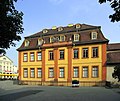Wittumspalais (Weimar)
The Wittumspalais is a museum in Weimar operated by the Weimar Classic Foundation . The building was the widow's residence of Duchess Anna Amalia for many years and was a center of social and literary life in Weimar during her lifetime.
History and description
The building was erected between 1767 and 1769 by Jakob Friedrich von Fritsch , privy councilor and minister in Weimar, on the site of a former Franciscan monastery as a city palace. The design comes from the Saxon master builder Johann Gottfried Schlegel . The building plot was in a representative position on the so-called Esplanade , today's Schillerstrasse. After the Weimar castle fire, the Duchess Anna Amalia lived in the palace from May 1774 and bought it in 1775 for a purchase price of 20,100 Reichstalers . Anna Amalia lived in the Wittumspalais until her death in 1807. The famous round tables of the Weimar Court of Muses also took place here, alongside those that gathered in the rural summer seats of Ettersburg (Ettersburg Castle and Park ) or Tiefurt Castle .
The interiors were designed from 1775 onwards. The ceiling paintings are by Adam Friedrich Oeser . After 1807 the palace was administered by the ducal court marshal's office. From 1808 to 1848 the Weimar Freemason Lodge Anna Amalia met for the three roses in the building. From 1833 to 1848, sessions of the state parliament took place in the ballroom. In 1848 the library of the reading museum was moved to the Wittumspalais. From 1858 the painter Leopold Graf von Kalckreuth used the ballroom as a studio. The painter Friedrich Preller used this room between 1864 and 1868 for his Odysseus cycle .
In 1870/71 the Grand Duke Carl Alexander commissioned extensive restoration work. In 1919 the Goethe National Museum took over the Wittumspalais.
The air raids on Weimar in World War II also hit the Wittumspalais: with severe roof damage and destroyed doors and windows. In 1949 it was able to reopen as a museum . The living rooms offer a clear picture of aristocratic living culture.
The Wittumspalais is part of the Ensemble Klassisches Weimar , which was declared a UNESCO World Heritage Site in 1998 .
literature
(in chronological order)
- Guido Schnaubert: The inner rooms of the Wittumspalais in Weimar. Panse's Verlag, Weimar 1912, DNB 57607280X .
- Guido Schnaubert: From Alt-Weimar's past. Volume 1: The Wittumspalais of the Duchess Anna Amalia. Panse's Verlag, Weimar 1912, DNB 368152766 .
- Hans Wahl : The Wittumspalais of the Duchess Anna Amalia. Verlag JJ Weber, Leipzig 1927, DNB 361831765 .
- Sigrid Anger: The Wittumspalais in Weimar. Goethe National Museum and Classical Sites, Weimar 1954, DNB 364949872 .
- Hedwig Weilguny: The Wittumspalais in Weimar. National Research and Memorial Centers for Classical German Literature, Weimar 1956, DNB 576900591 .
- Gertrud Ranft: The Wittumspalais in Weimar. Construction Verlag, Berlin / Weimar 1964, DNB 453912060 .
- Hedwig Weilguny: The Wieland Museum in the Wittumspalais in Weimar. National Research and Memorial Centers for Classical German Literature, Weimar 1966, DNB 458596167 (5th edition), Weimar 1981, DNB 820335630 .
- Willi Ehrlich : The Wittumspalais in Weimar. National research and memorial centers for classical German literature, Weimar 1970, DNB 850612756 (new edition, Weimar 1982, DNB 850612756 ).
- Egon Friday: Wieland Museum in the Wittumspalais in Weimar. National Research and Memorial Centers for Classical German Literature, Weimar 1986, DNB 210420065 .
- Isolde Bacher, Hans-Wilm Schütte: Weimar. 8th edition. Baedeker, Ostfildern 2013, ISBN 978-3-8297-1486-0 , pp. 236-237.
Web links
- Wittumspalais . In: Klassik-Stiftung.de
- Wittumspalais . In: Weimar.de
- Wittumspalais . In: AlleBurgen.de
Individual evidence
- ↑ Pictures of Destruction. Weimar 1945. Photos by Günther Beyer . Catalog for the exhibition in the Stadtmuseum 2015. p. 27.
Coordinates: 50 ° 58 ′ 46.8 ″ N , 11 ° 19 ′ 35.6 ″ E


